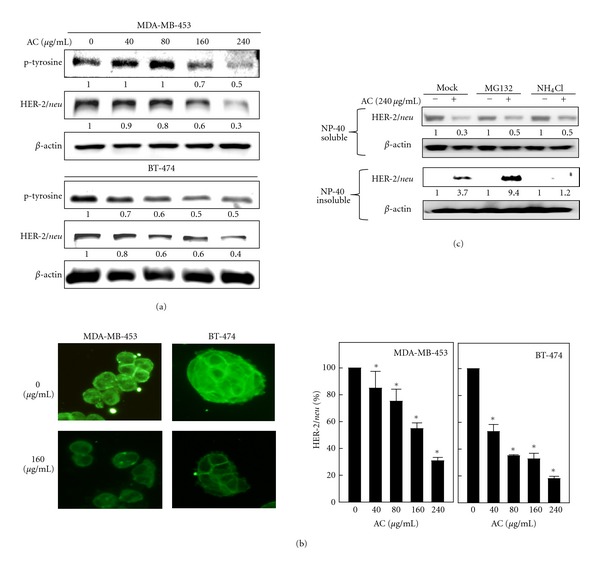Figure 2.

Inhibitory effect of AC on tyrosine phosphorylation and HER-2/neu depletion in HER-2/neu-overexpressing human breast cancer cell lines. (a) MDA-MB-453 or BT-474 cells were incubated with or without AC (40–240 μg/mL) at 37°C for 6–24 h. Immunoblotting was performed to measure levels of the HER-2/neu protein and tyrosine phosphorylation. The proteins (50 μg) in each sample were resolved by 8–15% SDS-PAGE, with β-actin serving as a control. (b) Changes in the subcellular distribution of HER-2/neu after a 24-h exposure to AC. MDA-MB-453 and BT-474 cells were grown on coverslips and treated with or without AC (40–240 μg/mL). Cells were fixed with 4% paraformaldehyde and stained with a HER-2/neu antibody followed by a fluorescein isothiocyanate-conjugated secondary antibody (green). The subcellular distribution was photographed by fluorescence microscopy. (c) MDA-MB-453 cells were pretreated with MG132 (5 μM) or NH4Cl (10 mM) for 30 min followed by AC (240 μg/mL) for 8 h, and the NP-40-soluble and NP-40-insoluble cell lysates were prepared and assessed by immunoblotting with antibodies against HER-2/neu and β-actin. Relative changes in protein bands were measured using densitometric analysis; the control was 1.0-fold, as shown immediately below the gel data. The results are presented as the mean ± SD of three independent experiments. *Significant difference in comparison to the control group (P < 0.05).
